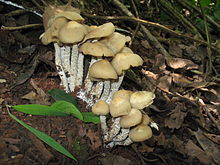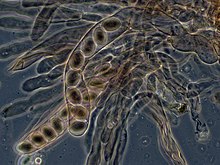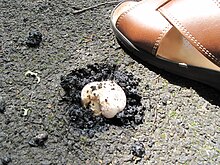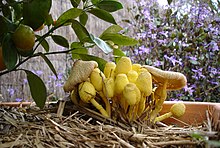Morphology
A mushroom develops from a nodule, or pinhead, less than two millimeters in diameter, called a
primordium, which is typically found on or near the surface of the
substrate. It is formed within the
mycelium, the mass of threadlike
hyphae that make up the fungus. The primordium enlarges into a roundish structure of interwoven hyphae roughly resembling an egg, called a "button". The button has a cottony roll of mycelium, the
universal veil, that surrounds the developing fruit body. As the egg expands, the universal veil ruptures and may remain as a cup, or
volva, at the base of the
stalk, or as warts or volval patches on the cap. Many mushrooms lack a universal veil, therefore they do not have either a volva or volval patches. Often, a second layer of tissue, the
partial veil, covers the bladelike
gills that bear
spores. As the cap expands, the veil breaks, and remnants of the partial veil may remain as a ring, or
annulus, around the middle of the stalk or as fragments hanging from the margin of the cap. The ring may be skirt-like as in some species of
Amanita, collar-like as in many species of
Lepiota, or merely the faint remnants of a cortina (a partial veil composed of filaments resembling a spiderweb), which is typical of the genus
Cortinarius. Mushrooms lacking partial veils do not form an annulus.
[10]
The stalk (also called the stipe, or stem) may be central and support the cap in the middle, or it may be off-center and/or lateral, as in species of
Pleurotus and
Panus. In other mushrooms, a stalk may be absent, as in the polypores that form shelf-like brackets.
Puffballs lack a stalk, but may have a supporting base. Other mushrooms, such as
truffles,
jellies,
earthstars, and
bird's nests, usually do not have stalks, and a specialized mycological vocabulary exists to describe their parts.
The way the gills attach to the top of the stalk is an important feature of mushroom morphology. Mushrooms in the genera
Agaricus,
Amanita,
Lepiota and
Pluteus, among others, have free gills that do not extend to the top of the stalk. Others have
decurrent gills that extend down the stalk, as in the genera
Omphalotus and
Pleurotus. There are a great number of variations between the extremes of free and decurrent, collectively called attached gills. Finer distinctions are often made to distinguish the types of attached gills: adnate gills, which adjoin squarely to the stalk; notched gills, which are notched where they join the top of the stalk; adnexed gills, which curve upward to meet the stalk, and so on. These distinctions between attached gills are sometimes difficult to interpret, since gill attachment may change as the mushroom matures, or with different environmental conditions.
[11]
Microscopic features
A
hymenium is a layer of microscopic spore-bearing cells that covers the surface of gills. In the nongilled mushrooms, the hymenium lines the inner surfaces of the tubes of
boletes and polypores, or covers the teeth of spine fungi and the branches of corals. In the Ascomycota, spores develop within microscopic elongated, sac-like cells called
asci, which typically contain eight spores in each ascus. The
Discomycetes, which contain the cup, sponge, brain, and some club-like fungi, develop an exposed layer of asci, as on the inner surfaces of
cup fungi or within the pits of
morels. The
Pyrenomycetes, tiny dark-colored fungi that live on a wide range of substrates including soil, dung, leaf litter, and decaying wood, as well as other fungi, produce minute, flask-shaped structures called
perithecia, within which the asci develop.
[12]
In the Basidiomycetes, usually four spores develop on the tips of thin projections called
sterigmata, which extend from club-shaped cells called a
basidia. The fertile portion of the
Gasteromycetes, called a
gleba, may become powdery as in the puffballs or slimy as in the
stinkhorns. Interspersed among the asci are threadlike sterile cells called
paraphyses. Similar structures called
cystidia often occur within the hymenium of the Basidiomycota. Many types of cystidia exist, and assessing their presence, shape, and size is often used to verify the identification of a mushroom.
[12]
The most important microscopic feature for identification of mushrooms is the spores. Their color, shape, size, attachment, ornamentation, and reaction to
chemical tests often can be the crux of an identification. A spore often has a protrusion at one end, called an apiculus, which is the point of attachment to the basidium, termed the apical
germ pore, from which the hypha emerges when the spore germinates.
[12]
Growth
Many species of mushrooms seemingly appear overnight, growing or expanding rapidly. This phenomenon is the source of several common expressions in the
English language including "to mushroom" or "mushrooming" (expanding rapidly in size or scope) and "to pop up like a mushroom" (to appear unexpectedly and quickly). In reality all species of mushrooms take several days to form primordial mushroom fruit bodies, though they do expand rapidly by the absorption of fluids.
The
cultivated mushroom as well as the common
field mushroom initially form a minute
fruiting body, referred to as the pin stage because of their small size. Slightly expanded they are called buttons, once again because of the relative size and shape. Once such stages are formed, the mushroom can rapidly pull in water from its
mycelium and expand, mainly by inflating preformed
cells that took several days to form in the
primordia.
Similarly, there are even more ephemeral mushrooms, like
Parasola plicatilis (formerly
Coprinus plicatlis), that literally appear overnight and may disappear by late afternoon on a hot day after rainfall.
[13] The primordia form at ground level in lawns in humid spaces under the
thatch and after heavy rainfall or in
dewy conditions balloon to full size in a few hours, release spores, and then collapse. They "mushroom" to full size.
Not all mushrooms expand overnight; some grow very slowly and add tissue to their fruitbodies by growing from the edges of the colony or by inserting
hyphae. For example,
Pleurotus nebrodensis grows slowly, and because of this combined with human collection, it is now
critically endangered.
[14]
Though mushroom fruiting bodies are short-lived, the underlying
mycelium can itself be long-lived and massive. A colony of
Armillaria solidipes (formerly known as
Armillaria ostoyae) in
Malheur National Forest in the
United States is estimated to be 2,400 years old, possibly older, and spans an estimated 2,200 acres (8.9 km
2). Most of the fungus is underground and in decaying wood or dying tree roots in the form of white mycelia combined with black shoelace-like
rhizomorphs that bridge colonized separated woody substrates.
[15]
It has been suggested the electrical stimulus of a lightning bolt striking mycelia in logs accelerates the production of mushrooms.
[16]
















